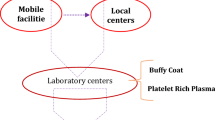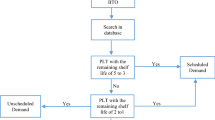Abstract
Resource sharing, as a coordination mechanism, can mitigate disruptions in supply and changes in demand. It is particularly crucial for platelets because they have a short lifespan and need to be transferred and allocated within a limited time to prevent waste or shortages. Thus, a coordinated model comprised of a mixed vertical-horizontal structure, for the logistics of platelets, is proposed for disaster relief operations in the response phase. The aim of this research is to reduce the wastage and shortage of platelets due to their critical role in wound healing. We present a bi-objective location-allocation robust possibilistic programming model for designing a two-layer coordinated organization strategy for multi-type blood-derived platelets under demand uncertainty. Computational results, derived using a heuristic ε-constraint algorithm, are reported and discussed to show the applicability of the proposed model. The experimental results indicate that surpluses and shortages in platelets remarkably declined following instigation of a coordinated disaster relief operation.





Similar content being viewed by others
References
Abounacer, R., Rekik, M., & Renaud, J. (2014). An exact solution approach for multi-objective location-transportation problem for disaster response. Computers & Operation Research, 41, 83–93.
Afshar, A., & Haghani, A. (2012). Modeling integrated supply chain logistics in real-time large-scale disaster relief operations. Socio-Economic Planning Sciences, 46, 327–338.
Altay, N., & Green, W. (2006). OR/MS research in disaster operation management. European Journal of Operational Research, 175, 475–493.
Balcik, B., Beamon, B. M., Krejci, C. C., Muramatsu, K. M., & Ramirez, M. (2010). Coordination in humanitarian relief chain: Practices, challenges and opportunities. International Journal of Production Economics, 126, 22–34.
Barbarosoglu, G., & Arda, Y. (2004). A two-stage stochastic programming framework for transportation planning in disaster response. The Journal of the Operational Research Society, 55, 43–53.
Barbarosoglu, G., Ozdamar, L., & Cevik, A. (2002). An interactive approach for hierarchical analysis of helicopter logistics in disaster relief operations. European Journal of Operational Research, 140, 118–133.
Ben-Tal, A., Chung, B. D., Mandala, S. R., & Yao, T. (2011). Robust optimization for emergency logistics planning: Risk mitigation in humanitarian relief supply chains. Transportation Research Part B, 45, 1177–1189.
Bozorgi-Amiri, A., Jabalameli, M. S., & Al-e-Hashem, S. M. J. M. (2013). A multi-objective robust stochastic programming model for disaster relief logistics under uncertainty. OR Spectrum, 35(4), 905–933.
Caunhye, A. M., Nie, X., & Pokharel, S. (2012). Optimization models in emergency logistics: A literature review. Socio-Economic Planning Sciences, 46, 4–13.
Chung, Y. T., Erhun, F., & Kraft, T. (2014). Improving Standford blood Center's platelets supply chain. New Jersey: Pearson Education, Inc..
Davis, L. B., Samanlioglu, F., Qu, X., & Root, S. (2013). Inventory planning and coordination in disaster relief efforts. International Journal of Production Economics, 141, 561–573.
Edrissi, A., Poorzahedy, H., Nassiri, H., & Nourinejad, M. (2013). A multi-agent optimization formulation of earthquake disaster prevention and management. European Journal of Operational Research, 229, 261–275.
Gunpinar, S., & Centeno, G. (2015). Stochastic integer programming models for reducing wastage and shortage of bloods at hospitals. Computers & Operations Research, 54, 129–141.
Hess, J. R., & Thomas, M. J. G. (2003). Blood use in war and disaster: Lessons from the past century. Transfusion, 43, 1622–1633.
Huang, K., Jiang, Y., Yuan, Y., & Lindu, Z. (2015). Modeling multiple humanitarian objectives in emergency response to large-scale disasters. Transportation Research Part E, 75, 1–17.
Jabbarzadeh, A., Fahimnia, B., & Seuring, S. (2014). Dynamic supply chain network design for the supply of blood in disaster: A robust model with real world application. Transportation Research Part E, 70, 225–244.
Janssen, M., Lee, J., Bharosa, N., & Cresswell, A. (2010). Advances in multi-agency disaster management: Key elements in disaster research. Information Systems Frontiers, 12(1), 1–7.
Li, N., Sun, M., Bi, Z., Su, Z., & Wang, C. (2014). A new methodology to support group decision-making for IoT-based emergency response systems. Information Systems Frontiers, 16(5), 953–977.
Liberatore, F., Ortuno, M., Tirado, G., Vitoriano, B., & Scaparra, M. (2014). A hierarchical compromise model for the joint optimization of recovery operations and distribution of emergency goods in humanitarian logistics. Computers & Operations Research, 42, 3–13.
Moreno, A., Alem, D., & Ferreira, D. (2016). Heuristic approaches for the multiperiod location-transportation problem with reuse of vehicles in emergency logistics. Computers & Operations Research, 69, 79–96.
Nagurney, A., Masoumi, A. H., & Yu, M. (2012). Supply chain network operations management of a blood banking system with cost and risk minimization. Computational Management Science, 9(2), 205–231.
Najafi, M., Eshghi, K., & Leeuw, S. d. (2014). A dynamic dispatching and routing model to plan/re-plan logistics activities in response to an earthquake. OR Spectrum, 36, 323–356.
Norouzi, M., Ahmadi, A., Esmaeel Nezhad, A., & Ghaedi, A. (2014). Mixed integer programming of multi-objective security-constrained hydro/thermal unit commitment. Renewable and Sustainable Energy Reviews, 29, 911–923.
Onur Mete, H., & Zabinsky, Z. B. (2010). Stochastic optimization of medical supply location and distribution in disaster management. International Journal of Production Economics, 126, 76–84.
Ozdamar, L., & Ertem, M. A. (2014). Models, solutions and enabling technologies in humanitarian logistics. European Journal of Operational Research, 244(1), 55–65.
Ozdamar, L., Ekinci, E., & Kucukyazici, B. (2004). Emergency logistics planning in natural disasters. Annals of Operational Research, 129, 217–245.
Paul, J., & MacDonald, L. (2016). Optimal location, capacity and timing of stockpiles for improved hurricane preparedness. International Journal of Production Economics, 174, 1–50.
Pierskala, W. P. (2003). Supply chain management of blood banks. International Series in Operations Research & Management Science, 70, 103–145. https://doi.org/10.1007/1-4020-8066-2_5.
Pishvaee, M., Razmi, J., & Torabi, S. (2012). Robust Possibilistic programming for socially responsible supply chain network design: A new approach. Fuzzy Sets and Systems, 206, 1–20.
Poblet, M., Garcia-Cuesta, E., & Casanovas, P. (2017). Crowdsourcing roles, methods and tools for data-intensive disaster management. Information Systems Frontiers, 1–17. https://doi.org/10.1007/s10796-017-9734-6.
Pradhananga, R., Mutlu, F., Pokharel, S., Holguín-Veras, J., & Seth, D. (2016). An integrated resource allocation and distribution model for pre-disaster planning. Computers & Industrial Engineering, 91, 229–238.
Raju, E., & Becker, P. (2013). Multi-organizational coordination for disaster recovery: The story of post-tsunami Tamil Nadu, India. International Journal of Disaster Risk Reduction, 4, 82–91.
Raju, E., & Van Niekerk, D. (2013). Intra-governmental coordination for sustainable disaster recovery: A case-study of the Eden District municipality, South Africa. International Journal of Disaster Risk Reduction, 4, 92–99.
Rossel, P. O., Herskovic, V., & Ormeno, E. (2016). Creating a family of collaborative applications for emergency management in the firefighting sub-domain. Information Systems Frontiers, 18(1), 69–84.
Salmeron, J., & Apte, A. (2010). Stochastic optimization for natural disaster asset prepositioning. Production and Operations Management, 19(5), 561–574.
Schulz, S. F., & Blecken, A. (2010). Horizontal cooperation in disaster relief logistics: Benefits and impediments. International Journal of Physical Distribution and Logistics Management, 40, 636–656.
Sheu, J. B. (2007). An emergency logistics distribution approach for quick response to urgent relief demand in disasters. Transportation Research Part E, 43, 687–709.
Sheu, J. B., & Pan, C. (2014). Relief supply collaboration for emergency logistics responses to large-scale disasters. Transportmetrica A: Transport Science, 11, 210–242.
Shokar, I., Torabi, S.A., (2017). An enhanced reverse auction framework for relief procurement management. International Journal of Disaster Risk Reduction, 24, 66–80.
Talaei, M., Moghaddam, B. F., Pishvaee, M., Bozorgi-Amiri, A., & Gholamnejad, S. (2016). A robust fuzzy optimization model for carbon-efficient closed-loop supply chain network design problem: A numerical illustration in electronics industry. Journal of Cleaner Production, 113, 662–673.
Tofighi, S., Torabi, S., & Mansouri, S. (2016). Humanitarian logistics network design under mixed uncertainty. European Journal of Operational Research, 250(1), 239–250.
Toner, R. W., Pizzi, L., Leas, B., Ballas, S. K., Quigley, A., & Goldfarb, N. I. (2011). Cost to hospitals of acquiring and processing blood in the US: A survey of hospital-based blood banks and transfusion services. Applied Health Economics and Health Policy, 9(1), 29–37.
Wang, L., Song, J., & Shi, L. (2015). Dynamic emergency logistics planning: Models and heuristic algorithm. Optimization Letters, 9(8), 1533–1552.
Yi, W., & Ozdamar, L. (2007). A dynamic logistics coordination model for evacuation and support in disaster response activities. European Journal of Operational Research, 179, 1177–1193.
Zahiri, B., Tavakkoli-Moghaddam, R., & Pishvaee, M. (2014). A robust possibilistic programming approach to multi period location-allocation of organ transplant centers under uncertainty. Computers & Industrial Engineering, 74, 139–148.
Acknowledgements
We wish to express our sincere thanks to the anonymous referee and the Editorial office for their through and constructive review that have helped us improve both the presentation of the work and the methodologies developed here. We are also most grateful to Professor Hua Cai whose valuable support led to a significant improvement in the article.
Author information
Authors and Affiliations
Corresponding author
Appendices
Appendix 1. Case Data Studied
Appendix 2. Linearization Technique
In this technique, interactions between discrete and binary variables are changed by replacing the product of interacting variables to new discrete variables. The linearization variable is called y and reflects the products of x (discrete variable) and d (binary) in the process of linearization. The lower bound and upper bound of x are assumed to be known and take the values of L and U, respectively. The linear mixed-integer programming model after linearization process is:
Rights and permissions
About this article
Cite this article
Kamyabniya, A., Lotfi, M.M., Naderpour, M. et al. Robust Platelet Logistics Planning in Disaster Relief Operations Under Uncertainty: a Coordinated Approach. Inf Syst Front 20, 759–782 (2018). https://doi.org/10.1007/s10796-017-9788-5
Published:
Issue Date:
DOI: https://doi.org/10.1007/s10796-017-9788-5




